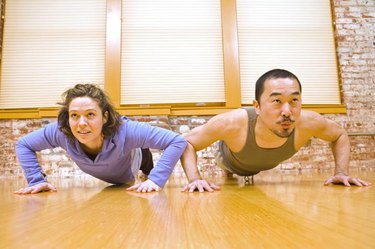
Push-ups and pull-ups are fundamental movements that often get overlooked when strength training because of their simplicity. However, they are one of the best ways to stay fit while you travel or when you're crunched for time and can't make the gym. Each exercise can be changed and tweaked to challenge even the most seasoned exercise enthusiasts.
Known as compound movements, push-ups and pull-ups recruit multiple muscle groups at once — and the more muscle groups you work at one time, the more calories you'll burn. These are exercises that should be a part of any training regimen, as they help you build a stronger back, chest, arms, shoulders, and core.
Video of the Day
Video of the Day
How to Do a Proper Push-Up
There is no better way to build a bigger chest, stronger shoulders and more defined arms than push-ups.
Depending on the width of your hands, push-ups will either target more of your chest or triceps. The farther your hands are from your body, the more of you use your chest muscles. The closer your hands are to your chest, the more you'll use your triceps to push your bodyweight up from the ground.
Push-ups are performed by placing your hands under your shoulders with your legs behind you, in the same position as a plank. For proper push-ups, maintain a straight back, and then slowly bend your elbows until your chest touches or slightly hovers over the ground.
Your arms should stay at a 90-degree angle as you lower your chest to the ground. Once reach the bottom of the exercise, push your body back up until your arms are fully extended. Perform three sets of eight to 12 repetitions.
Make your push-ups more difficult by adding a weight plate on your back as you perform the exercise.
Read More: Why I'm Getting Weaker Doing Push-Ups
Doing a Pull-Up
Pull-ups build more than strength in your back. They also require a great deal of strength from your arms, core and shoulders, as well. Often skipped by many weight lifting enthusiasts, pull-ups can help you build a more defined and stronger back.
To execute a pull-up, find an overhead bar and grab the bar with a slightly wider than shoulder-width grip.
Your starting position begins with your body in a fully hanging position. To begin the first step of the pull-up, squeeze your core and engage your glutes, as this helps provide an all-around stable area of muscle tension for your back muscles. This will help make your pull-up easier.
Then, start the motion by pulling your shoulder blades down, as if they're going into your back pocket, bending your elbows and pull your chest towards the bar. Once your chest meets the bar or your head is above the bar, hold the position for 1-2 seconds.
Then slowly allow your body to return to the full hanging position. Perform three sets of 8-12 reps.
Tip
For those that can't perform pull-ups, the lat pulldown machine is a viable substitute for pull-ups.

Keep It Fresh with Variations
Push-ups and pull-ups may not sound as exciting as lifting a heavy barbell or dumbbell. With a few tweaks to these exercises, however, you can challenge your body and muscles in different ways. Changing the position of your hands can change which muscles are targeted or force other stabilizer muscles to work harder.
If you're tired of the same standard push-up, you can change the angle at which you perform the exercise and do a decline push-up. To perform this exercise, place your feet on an elevated surface. Place your hands in the normal position for a push-up and get into the normal push-up position with your legs extended and elevated behind you. Then, like a regular push-up, lower your body until your chest touches the floor. Then push your body back to the starting position.
Pull-ups can be changed by taking a wider grip on the pull-up bar. Or, you can modify the pull-up and hit more of your biceps by performing a chin-up. Like the pull-up, the movement for the chin-up is the same. The only difference is that now the palms of your hands are facing toward you and your grip is slightly more narrow than shoulder width.
Read More: Pull-Ups for Bulking
Strength-Building Workout
One of the best ways to train both push-ups and pull-ups is to combine them into a circuit workout. For a circuit workout, you'll perform both exercises without resting between each and only resting at the end of the last rep for less than 60 seconds.
For instance, your circuit might require you to perform 10 reps of push-ups, followed by 10 reps of pull-ups. Once you've finished the last rep of the pull-ups, rest for 60 seconds or less. You can set a timer for 5 to 10 minutes and see how many rounds you can complete before the timer goes off.
Pick three variations of these exercises and perform three sets of 10 reps of each variation. That workout would look something like this:
- Push-ups: three sets of eight to 10 reps
- Pull-ups: three sets of eight to 10 reps
- Tricep push-ups (bring your hand together to form a diamond directly underneath your chest): three sets of eight to 10 reps
- Chin-ups: three sets of eight to 10 reps
- Decline push-ups: three sets of eight to 10 reps
- Wide-grip pull-ups: three sets of eight to 10 reps